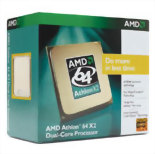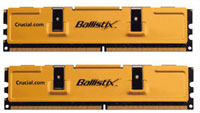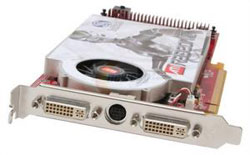Upgraded AMD Midrange Platform
Moving on to the upgraded recommendations for our midrange platforms, the AMD vs. Intel story doesn't change much. Motherboard options on the AMD platform are better if you're looking for multiple GPU support, while overall performance is going to be lower. We have upgraded almost every component in order to provide a better overall system. Base performance will be higher, overclocking capability will generally be better, and the expansion options are also improved. Here is the upgraded AMD platform recommendation.
 |
If you're willing to choose an AMD platform right now, processor performance shouldn't be your primary concern. As we have stated, Intel's Core 2 Duo is going to be faster at virtually every price point. Nevertheless, we have upgraded the CPU slightly from the 3800+ to the 4200+. That adds 10% more CPU clock speed for a 22% increase in CPU cost. Other than the discontinued 1 MB cache 4000+, which will be slower than the 4200+ in nearly every instance, the next possible CPU upgrade for socket AM2 is the 4600+. That adds another 200 MHz but it costs $110 more, so we really wouldn't go beyond the 4200+ if you're trying to build a midrange computer.
 |
We have a few options on the motherboard as an "upgrade". We typically feel nForce 590 SLI boards are a bit too expensive to fit into a midrange budget, and they really don't offer a lot more performance than nForce 570 SLI anyway. Instead of making a minor upgrade to the chipset performance, we have swapped NVIDIA chipsets for an ATI chipset, thus gaining CrossFire support and losing SLI support (official support at least). Unfortunately, while our initial look at the ATI Xpress 3200 showed that it was a capable overclocker, few manufactures seem to have fully tapped the potential. If you're looking for maximum overclocking capability, you may need to stick with an nForce 570/590 chipset, but the MSI K9A Platinum still performs well and offers a moderate amount of overclocking support.
 |
We upgraded the memory selection for both platforms, although Core 2 Duo is more likely to make use of the extended bandwidth. Memory prices are extremely volatile right now, with both AMD and Intel moving to DDR2 and the impending holiday season. The Crucial 2x1024MB PC2-6400 Ballistix uses high quality Micron memory and is rated for 4-4-4-12 and 2.2V operation. It should reach as high as DDR2-1000 and 5-5-5-15 timings with 2.3V, and possibly a bit more if you go beyond 2.3V. That is certainly enough bandwidth for socket AM2, and all but the most extreme overclocks with Core 2 Duo shouldn't present a problem. As before, many other manufacturers offer competing RAM: Corsair, G.Skill, OCZ, PDP, and others manufacture memory rated at DDR2-800 or higher, although prices can quickly reach extreme levels for the highest performance memory. We have already changed the memory recommendation once, due to rapidly fluctuating prices. Hopefully the RAM prices will return to normal soon, although it may take until the New Year for that to happen.
 |
With the change to an ATI chipset, it shouldn't come as a surprise that we also changed to an ATI graphics card, the Sapphire X1900 GT. The X1900 GT offers competitive performance to its NVIDIA counterpart (the 7900 GS), and prices are similar. Depending on your game of choice, the X1900 GT may be slower or faster than a 7900 GS, and overclocked 7900 GS cards are also available. With the ATI Xpress 3200 chipset, however, you will probably prefer an ATI graphics card. If you should instead decide to stick with an nForce 570 SLI motherboard, 7900 GS cards are readily available. The EVGA GeForce 7900GS KO 256MB HDCP offers some interesting features that the Sapphire X1900 GT lacks, for example HDCP support. For gamers on a budget, either card should suffice, and either card can be upgraded to a dual-GPU solution in the future should you so desire.














49 Comments
View All Comments
JarredWalton - Tuesday, October 3, 2006 - link
For a moderate system, I like PSU fan + front fan + rear fan (all 120mm if possible, with lower RPMs). More than two case fans gets to be overkill, and you could probably run a single 120mm rear case fan without problems.jonp - Thursday, September 28, 2006 - link
I think the E6400 base is 2.13GHz not 2.16Ghz.http://www.intel.com/products/processor/core2duo/s...">http://www.intel.com/products/processor/core2duo/s...
JarredWalton - Thursday, September 28, 2006 - link
It is. Did I mess that up somewhere? Ah: I had it right in the table but missed it in the text below. Sorry. It's been corrected now.jonp - Wednesday, September 27, 2006 - link
The MSI P965 Neo-F takes a beating by Newegg buyers:http://www.newegg.com/Product/Product.asp?Item=N82...">http://www.newegg.com/Product/Product.asp?Item=N82...
The trouble folks are having with the MB make me wonder
if the choice should be rethought? Or at least, if you're thinking
about it, read the experiences folks are having so you are
prepared make the choice work for you.
Jon
JarredWalton - Wednesday, September 27, 2006 - link
The original BIOS adhered directly to Intel's specs so memory not capable of 1.8V at boot or over DDR2-800 JEDEC had issues. (Of course this happened on just about all of the P965 boards! P965 at launch was a joke - just ask Gary Key.) MSI is still working on updating the BIOS, but the current version now works fine with DDR2-800 or below 1GB modules. You did note that the system recommendation included 2x1GB of DDR2-667, right?Anyway, this is a base P965 board, and it has limited overclocking and other capabilities. Anyone buying it thinking they are going to get an awesome OC is nuts, and that's likely where the negative comments on Newegg come from. Buying higher-end RAM and putting it in a lower-end motherboard often results in problems. I have a lot of motherboards that won't POST at all with some OCZ DDR2-800 RAM that wan'ts 2.2V for 3-3-3 timings, or 1.8V for 5-5-5 timings.
How far can the MSI P965 go? I believe the current BIOS limit is 350 MHz, with 325-333 being a reasonable target. Set your RAM for DDR2-533 and the FSB for 333 MHz, and you shouldn't have issues (provided the CPU can handle the OC - and almost every 2MB Core 2 Duo should do that OC without problems).
As I mentioned above, anyone can get on the internet and post a "review". We have no idea if they're really experienced or just complete noobs, and you certainly get what you pay for to an extent. It's a good baseline motherboard, but it won't set any performance records. We tried to keep the budget as close to $1000 as possible, so every $25 increase becomes significant.
jonp - Thursday, September 28, 2006 - link
As an alternative I would like to consider the Asus P5LD2, ver 2.01g which supports Core 2 Duo.Memory: DDR2-667 and 4GB -- this fits midrange to me
PCIe: 1 extra
PATA: 4 additional ATA100 *** especially good for those of us still in transition
SATA 3GB: 4 instead of 5
SATA RAID: included
Albeit not the Deluxe version from the http://www.anandtech.com/showdoc.aspx?i=2753&p...">Pre-AM2 Mid-Range Buyers Guide, May 2006 but a more mature solution (than the MSI) with features that help make the Core 2 Duo/SATA transition and it's almost the same price.
JarredWalton - Thursday, September 28, 2006 - link
The MSI board fully supports up to 8GB of RAM as long as it's DDR2-667 or lower. (Officially at least - it should now run 4x1GB DDR2-800, though perhaps not at super-tight timings.) About the only advantage of the ASUS 945P P5LD2 R2.0 is that it has more IDE ports. The MSI board has FireWire. Which is more important? That's up to the individual - for HTPC use FireWire is great, but not too much else for the majority of users. I can make a similar argument about IDE support.The Buyer's Guides are written targeting new PC builds rather than as a specific upgrade recommendation. It could be that the ASUS is a better upgrade option for those that have IDE hard drives they want to keep. In most areas I wouldn't call it "better" than the MSI, though - just different. It's also $14 more than the MSI, and getting very close to the Gigabyte S3 in price.
jonp - Thursday, September 28, 2006 - link
The Gigabyte S3 is $8 more than the Asus and has the same 2 PATA device support as the MSI.Does the MSI P965 Neo-F support 1394? I couldn’t find it on the Newegg nor MSI web sites – confused.
Different: Is the Asus less finicky about memory and more OC friendly than the MSI or is that my misimpression?
Jon
JarredWalton - Thursday, September 28, 2006 - link
Oop... you're right, the stock P965 doesn't have firewire. Got it confused with the MSI K9A board.For memory support, the 945P doesn't officially support DDR2-800, so if you impose the same limitation on the MSI P965 it should do just as well on RAM support. Both will likely unofficially support 2x1GB DDR2-800 memory (the ASUS only with overclocking). In terms of overclocking, both are going to top out around the same ~333 FSB. Chipset performance of P965 is slightly better than 945P (less than 5%, though).
If you're set on using more than two PATA devices, then you will need an older motherboard with more IDE ports or you will need a board with an extra chipset to add the support. As I said, I don't find it to be too big of a deal (I haven't purchased an IDE drive in a long time).
--Jarred
evonitzer - Wednesday, September 27, 2006 - link
It seems to me that having the Samsung monitor would be a big asset for gamers in that it supports a higher, and very common resolution. Is this not really a big consideration? Personally, I like the look of 16x12 a lot better than the 1280x1024 that my 17 and 19 inch screens have. And since I own an nvidia card, bumping up resolution works better that antialiasing sometimes. And on older titles, I can max out everything a little higher. Is this not a concern because of the high demands of new games, (ie. Oblivion) or because the jump from 1280x10 to 16x12 isn't really that big? Or something else?